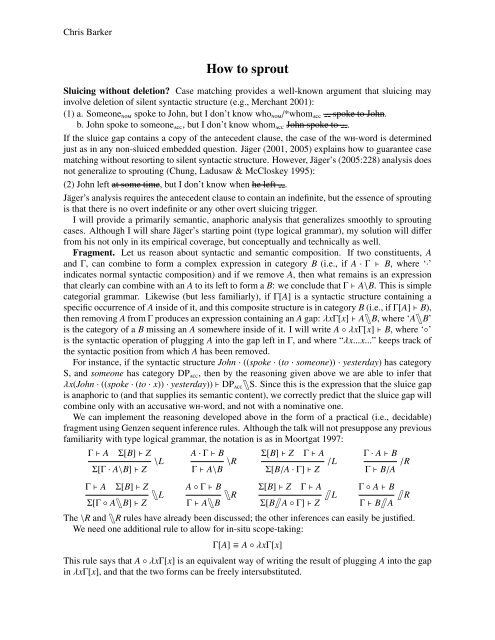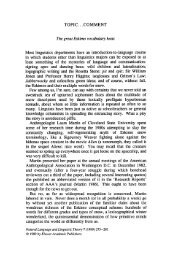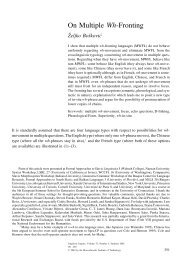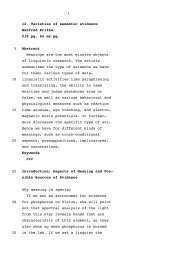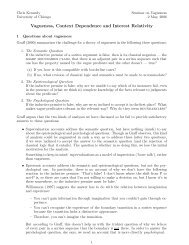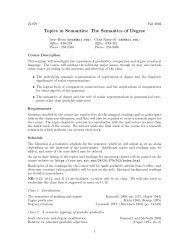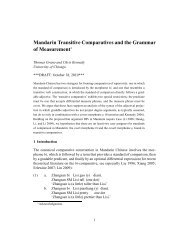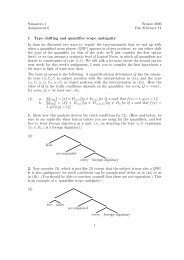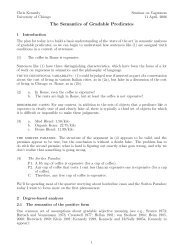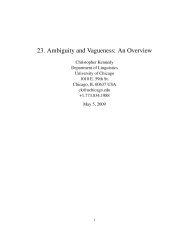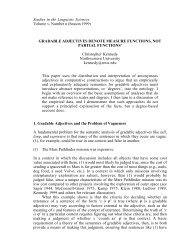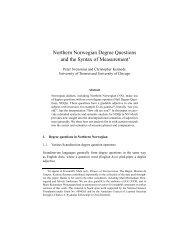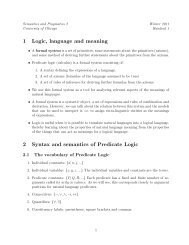On the natural history of negative polarity items - Syntax, Semantics ...
On the natural history of negative polarity items - Syntax, Semantics ...
On the natural history of negative polarity items - Syntax, Semantics ...
You also want an ePaper? Increase the reach of your titles
YUMPU automatically turns print PDFs into web optimized ePapers that Google loves.
Chris Barker<br />
How to sprout<br />
Sluicing without deletion? Case matching provides a well-known argument that sluicing may<br />
involve deletion <strong>of</strong> silent syntactic structure (e.g., Merchant 2001):<br />
(1) a. Someonenom spoke to John, but I don’t know whonom/*whomacc spoke to John.<br />
b. John spoke to someoneacc, but I don’t know whomacc John spoke to .<br />
If <strong>the</strong> sluice gap contains a copy <strong>of</strong> <strong>the</strong> antecedent clause, <strong>the</strong> case <strong>of</strong> <strong>the</strong> wh-word is determined<br />
just as in any non-sluiced embedded question. Jäger (2001, 2005) explains how to guarantee case<br />
matching without resorting to silent syntactic structure. However, Jäger’s (2005:228) analysis does<br />
not generalize to sprouting (Chung, Ladusaw & McCloskey 1995):<br />
(2) John left at some time, but I don’t know when he left .<br />
Jäger’s analysis requires <strong>the</strong> antecedent clause to contain an indefinite, but <strong>the</strong> essence <strong>of</strong> sprouting<br />
is that <strong>the</strong>re is no overt indefinite or any o<strong>the</strong>r overt sluicing trigger.<br />
I will provide a primarily semantic, anaphoric analysis that generalizes smoothly to sprouting<br />
cases. Although I will share Jäger’s starting point (type logical grammar), my solution will di⇤er<br />
from his not only in its empirical coverage, but conceptually and technically as well.<br />
Fragment. Let us reason about syntactic and semantic composition. If two constituents, A<br />
and , can combine to form a complex expression in category B (i.e., if A · ⇤ B, where ‘·’<br />
indicates normal syntactic composition) and if we remove A, <strong>the</strong>n what remains is an expression<br />
that clearly can combine with an A to its left to form a B: we conclude that ⇤ A\B. This is simple<br />
categorial grammar. Likewise (but less familiarly), if [A] is a syntactic structure containing a<br />
specific occurrence <strong>of</strong> A inside <strong>of</strong> it, and this composite structure is in category B (i.e., if [A] ⇤ B),<br />
<strong>the</strong>n removing A from produces an expression containing an A gap: ⇥x [x] ⇤ A)B, where ‘A)B’<br />
is <strong>the</strong> category <strong>of</strong> a B missing an A somewhere inside <strong>of</strong> it. I will write A ⇥x [x] ⇤ B, where ‘ ’<br />
is <strong>the</strong> syntactic operation <strong>of</strong> plugging A into <strong>the</strong> gap left in , and where “⇥x...x...” keeps track <strong>of</strong><br />
<strong>the</strong> syntactic position from which A has been removed.<br />
For instance, if <strong>the</strong> syntactic structure John · ((spoke · (to · someone)) · yesterday) has category<br />
S, and someone has category DPacc, <strong>the</strong>n by <strong>the</strong> reasoning given above we are able to infer that<br />
⇥x(John · ((spoke · (to · x)) · yesterday)) ⇤ DPacc)S. Since this is <strong>the</strong> expression that <strong>the</strong> sluice gap<br />
is anaphoric to (and that supplies its semantic content), we correctly predict that <strong>the</strong> sluice gap will<br />
combine only with an accusative wh-word, and not with a nominative one.<br />
We can implement <strong>the</strong> reasoning developed above in <strong>the</strong> form <strong>of</strong> a practical (i.e., decidable)<br />
fragment using Genzen sequent inference rules. Although <strong>the</strong> talk will not presuppose any previous<br />
familiarity with type logical grammar, <strong>the</strong> notation is as in Moortgat 1997:<br />
⇤ A ⇥[B] ⇤ Z \L<br />
⇥[ · A\B] ⇤ Z<br />
⇤ A ⇥[B] ⇤ Z )L<br />
⇥[ A)B] ⇤ Z<br />
A · ⇤ B \R<br />
⇤ A\B<br />
A ⇤ B )R<br />
⇤ A)B<br />
⇥[B] ⇤ Z ⇤ A /L<br />
⇥[B/A · ] ⇤ Z<br />
⇥[B] ⇤ Z ⇤ A ( L<br />
⇥[B( A ] ⇤ Z<br />
· A ⇤ B /R<br />
⇤ B/A<br />
A ⇤ B ( R<br />
⇤ B( A<br />
The \R and )R rules have already been discussed; <strong>the</strong> o<strong>the</strong>r inferences can easily be justified.<br />
We need one additional rule to allow for in-situ scope-taking:<br />
[A] ⇥ A ⇥x [x]<br />
This rule says that A ⇥x [x] is an equivalent way <strong>of</strong> writing <strong>the</strong> result <strong>of</strong> plugging A into <strong>the</strong> gap<br />
in ⇥x [x], and that <strong>the</strong> two forms can be freely intersubstituted.


